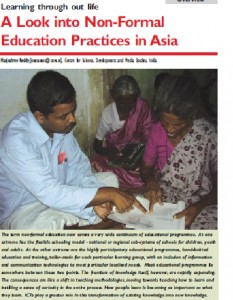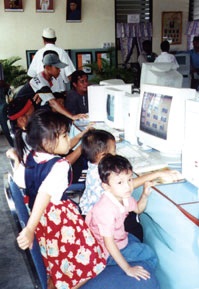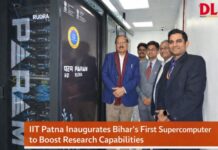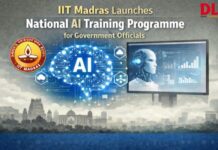 Countries have interpreted nonformal education in various ways. For some, it meant every educational programme provided by the Ministry of Education apart rom the schools and colleges, while others defined nonformal education as chooling like programmes provided by nongovernmental agencies. Various other countries have interpreted it as educational and training activities of different Ministries like Women’s Affairs, Health, Labour and Employment, Youth and Sports and Culture etc. Others again included within non-formal education, individualised learning programmes for different and specific learning groups. Some took it to mean every educational activity apart from schools and colleges, including radio and television programmes, the print media. In fact, it is very close to what some people define as ‘experiential learning’; and with the boons of information and communication technologies, now it is very close to total lifetime learning. Practices – varied in nature andscope In countries like Bangladesh and ndia, which still have to go a longway to ensure basic education for all children, the natural choice has been to adopt innovative methods, in most cases through ICTs to reach out-ofschool youth and adults. Both these countries have chosen to illustrate the ICT innovations through initiatives of non-government organiations. On the other hand, countries like Malaysia, which has made tremendous progress in recent years in terms of providing basic education for all, has chosen to focus on extending the benefits of information technology through continuing education programmes.
Countries have interpreted nonformal education in various ways. For some, it meant every educational programme provided by the Ministry of Education apart rom the schools and colleges, while others defined nonformal education as chooling like programmes provided by nongovernmental agencies. Various other countries have interpreted it as educational and training activities of different Ministries like Women’s Affairs, Health, Labour and Employment, Youth and Sports and Culture etc. Others again included within non-formal education, individualised learning programmes for different and specific learning groups. Some took it to mean every educational activity apart from schools and colleges, including radio and television programmes, the print media. In fact, it is very close to what some people define as ‘experiential learning’; and with the boons of information and communication technologies, now it is very close to total lifetime learning. Practices – varied in nature andscope In countries like Bangladesh and ndia, which still have to go a longway to ensure basic education for all children, the natural choice has been to adopt innovative methods, in most cases through ICTs to reach out-ofschool youth and adults. Both these countries have chosen to illustrate the ICT innovations through initiatives of non-government organiations. On the other hand, countries like Malaysia, which has made tremendous progress in recent years in terms of providing basic education for all, has chosen to focus on extending the benefits of information technology through continuing education programmes.
Lifelong or continuing education through nonformal means is becoming increasingly important in mobilising human resources in Malaysia, especially the youth. Approximately 1.2 million Malaysians currently have little or no access to ICTs. As one among the many fighters of the cause, Worldview Foundation conceived of the sm@sy (short for Smart Masyarakat meaning Smart Community) project in 1999 as a means of bringing nformation technology to rural Malaysia, as a powerful tool for communities to develop the new skill sets and knowledge they need to sustain themselves. sm@sy developed multimedia content in two languages, Malay and English, dealing with a wide range of topics specific to the residents of Kampung Raja Musa, which helped the residents, both computer illiterate and the illiterates as well to navigate offline and for free and to become a smart community. Penang e-learning community, ICT LitPro are some of the other such attempts made in the direction of making Malaysian communities smart with learning just in time. Non-formal educational programmes in Philippines are conducted by both public and private sector organizations. Within the government, the rimary agency is the Department of Education, Culture and Sports. The Bureau of Non formal Education runs a livelihood skills project in collaboration with SEAMEO-INNOTECH (South East Asian Ministers of Education- Regional Centre for Educational Innovation and Technology), which is called the evelopment of a Learning system for the Improvement of Life. This ommunity based education intervention seeks to improve the quality of life and develop skills needed locally within the community. In a rapidly changing country scenario, colleges and universities cater to such community demands and respond to their education requirements through a distance education movement. The University of Philippines has established the UPOU (University of Philippines Open University), an institutional arm that mbodies the philosophy of open learning. The UPOU operates within the system of a conventional university and remains linked to the academic programmes of the UP. UPOU reaches out through the distance and open learning modes to people who are not able to participate in classroom style education. The draft ICT Master Plan for 2005- 2008 of Office of the Non-Formal Education ommission (ONFEC) in Thailand focuses on areas like facilitating lifelong learning f Thai people through ICT, improving the quality of ICT services both for administration and for lifelong learning, providing ICT nfrastructures for local learning centers and ICT personnel development. FEC aims to develop various electronic learning materials, improve the quality of distance education, set up a courseware center, promote e-learning, develop e-books and set up e-libraries. Center for Education Technology (CET) under ONFEC runs Educational Television Station (ETV); similarly some distance education and e-learning programmes are also provided at this level. The responsibility that the Department of Non-Formal Education has undertaken is to organise non-formal education programmes for adults who have missed the opportunity for formal schooling or have dropped out. The programmes offered are Literacy Campaign project, functional literacy courses, Hill Areas education, and continuing education. In an innovative new experiment to bring ICTs to rural Thai villagers, the Population and Community
 Development Association (PDA) of Thailand has established a Community Based Integrated Rural Development (CBIRD) Centre for factory workers and students working or living in the neighbourhood. Field staff of the CBIRD Centre use the Internet connections provided by the project to research farmers’ problems and print out solutions for discussion with the farmers during their field visits. Furthermore, two schools nearby have established their own computer labs using grants partly received due to training schools’ teachers had undertaken at the Lighthouse Project on ICTs and the Internet. In Indonesia , the UNITeS (United Nations Information Technology Services) supported by UNESCO has integrating local Radio with the Internet through Multipurpose Community Telecentres has converged local radio and informatics via community telecentres in rural areas. The project focuses on strengthening civic education, dialog and transparency aimed at rooting asound democratic basis and good governance in rural Indonesian communities. Through dailyinteractive radio programmes theinformation available on the Internetis explored and visualised to alllisteners and the methods ofaccessing civic and other informationis illustrated. Combing this activitywith a community-radio/Internet cafe where individual studies can be carried out with guidance offered by trained staff, the access to ICT services is strongly improved. Even though India has made major strides over recent decades, script in computers and also to train rural youths in computer applications. A project ASHA -2005 was launched with the intention of reaching the most backward villages of Nagrota Surian block and help the villagers by imparting education and training in health, social welfare and environment. The world of corporate too encourages such attempts of restoring knowledge economy through innovations of ICTs by creating educational programmes which primarily focus on building educational infrastructure, mentoring, school dropout prevention, reading and literacy, scholarships, businesseducation partnerships and other local needs. Microsoft is working to bring the benefits of technology and education to one quarter of a billion people by2010 through its Unlimited Potentialprogramme that works with nonprofitsaround the world. It has
Development Association (PDA) of Thailand has established a Community Based Integrated Rural Development (CBIRD) Centre for factory workers and students working or living in the neighbourhood. Field staff of the CBIRD Centre use the Internet connections provided by the project to research farmers’ problems and print out solutions for discussion with the farmers during their field visits. Furthermore, two schools nearby have established their own computer labs using grants partly received due to training schools’ teachers had undertaken at the Lighthouse Project on ICTs and the Internet. In Indonesia , the UNITeS (United Nations Information Technology Services) supported by UNESCO has integrating local Radio with the Internet through Multipurpose Community Telecentres has converged local radio and informatics via community telecentres in rural areas. The project focuses on strengthening civic education, dialog and transparency aimed at rooting asound democratic basis and good governance in rural Indonesian communities. Through dailyinteractive radio programmes theinformation available on the Internetis explored and visualised to alllisteners and the methods ofaccessing civic and other informationis illustrated. Combing this activitywith a community-radio/Internet cafe where individual studies can be carried out with guidance offered by trained staff, the access to ICT services is strongly improved. Even though India has made major strides over recent decades, script in computers and also to train rural youths in computer applications. A project ASHA -2005 was launched with the intention of reaching the most backward villages of Nagrota Surian block and help the villagers by imparting education and training in health, social welfare and environment. The world of corporate too encourages such attempts of restoring knowledge economy through innovations of ICTs by creating educational programmes which primarily focus on building educational infrastructure, mentoring, school dropout prevention, reading and literacy, scholarships, businesseducation partnerships and other local needs. Microsoft is working to bring the benefits of technology and education to one quarter of a billion people by2010 through its Unlimited Potentialprogramme that works with nonprofitsaround the world. It has  teamed with the Beijing Xicheng District Library toassist rural migrant workers, working with the Hong Kong Federation ofYouth Groups (HKFYG) to launch“Cyber SPOTS” to provide computerskills training to underprivileged youth, implementing the programme in four Indian states: Punjab, MadhyaPradesh, Uttar Pradesh, and Haryanato deliver ICT skills training curriculum for women and girls. It also works with someother countries like Korea, Sri Lanka and Philippines.Others like Coca-Cola and Intel tooare seen quite active in taking the goal forward. By 2005, Coca-Cola hadincreasing by six-fold the number of children enrolled in primary schooling, probably a larger number of older youth received little or no schooling at all. India seeks to improve the basic skills, literacy and entry vocational skills of out-of-school youth and young adults in poor communities in several India states through non-formal programmes like Bridges to the Future Initiative (BFI). BFI includes three components development of ICT-based software tools to improve basic education, literacy, and entry level vocational education for teacher training; creation of community learning and technology centres (CLTCs) for social and economic information resources(e.g. health, agriculture, HIV/AIDS prevention, etc.) and lifelong learning; and implementation of advanced ICTsupported services to disadvantaged regions.The programme of rural awareness started by a non-government social organisation, the Science Awareness Trust (SAT), is also a huge success in the remote villages of Nagrota Surian block in Kangra district of Himachal.The organisation planned to educatethe illiterate adults by using Devnagri Information and communication technology (ICT) is now so pervasive, and so powerful, that major changes in learning simply must follow. The effective employment of new technology in education requires a rethink about methods, one that particularly applies in the context of the radical goals associated with the lifelong learning agenda. The main rationale of this agenda is to draw in to new learning opportunities people who have not previously benefited fully, or at all, from education or training. Also, in the most ambitious way, to reposition education and training so that they will no longer be undertaken at a particular stage of life, providing a single platform of knowledge and skill which will last for a whole career, or for a lifetime. Rather, this learning has to become a synonym for sustainability of the knowledge economy: for a world where knowledge and skills are continuous, and where people build their own knowledge and skill profiles from an instantly accessible menu of learning delivered just in time.
teamed with the Beijing Xicheng District Library toassist rural migrant workers, working with the Hong Kong Federation ofYouth Groups (HKFYG) to launch“Cyber SPOTS” to provide computerskills training to underprivileged youth, implementing the programme in four Indian states: Punjab, MadhyaPradesh, Uttar Pradesh, and Haryanato deliver ICT skills training curriculum for women and girls. It also works with someother countries like Korea, Sri Lanka and Philippines.Others like Coca-Cola and Intel tooare seen quite active in taking the goal forward. By 2005, Coca-Cola hadincreasing by six-fold the number of children enrolled in primary schooling, probably a larger number of older youth received little or no schooling at all. India seeks to improve the basic skills, literacy and entry vocational skills of out-of-school youth and young adults in poor communities in several India states through non-formal programmes like Bridges to the Future Initiative (BFI). BFI includes three components development of ICT-based software tools to improve basic education, literacy, and entry level vocational education for teacher training; creation of community learning and technology centres (CLTCs) for social and economic information resources(e.g. health, agriculture, HIV/AIDS prevention, etc.) and lifelong learning; and implementation of advanced ICTsupported services to disadvantaged regions.The programme of rural awareness started by a non-government social organisation, the Science Awareness Trust (SAT), is also a huge success in the remote villages of Nagrota Surian block in Kangra district of Himachal.The organisation planned to educatethe illiterate adults by using Devnagri Information and communication technology (ICT) is now so pervasive, and so powerful, that major changes in learning simply must follow. The effective employment of new technology in education requires a rethink about methods, one that particularly applies in the context of the radical goals associated with the lifelong learning agenda. The main rationale of this agenda is to draw in to new learning opportunities people who have not previously benefited fully, or at all, from education or training. Also, in the most ambitious way, to reposition education and training so that they will no longer be undertaken at a particular stage of life, providing a single platform of knowledge and skill which will last for a whole career, or for a lifetime. Rather, this learning has to become a synonym for sustainability of the knowledge economy: for a world where knowledge and skills are continuous, and where people build their own knowledge and skill profiles from an instantly accessible menu of learning delivered just in time.
























